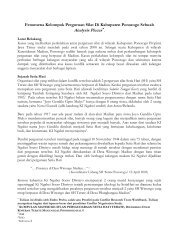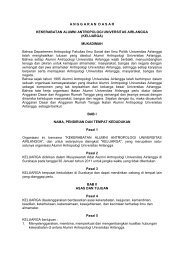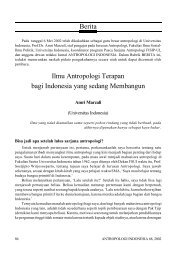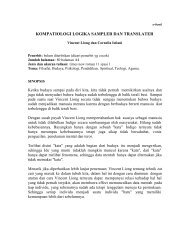The Future of Visual Anthropology: Engaging the Senses
The Future of Visual Anthropology: Engaging the Senses
The Future of Visual Anthropology: Engaging the Senses
You also want an ePaper? Increase the reach of your titles
YUMPU automatically turns print PDFs into web optimized ePapers that Google loves.
widijanto judono e-Library collection - widijanto.wordpress.com<br />
Chapter 1<br />
<strong>Engaging</strong> <strong>the</strong> visual<br />
An introduction<br />
Situating visual <strong>Engaging</strong> anthropology <strong>the</strong> visual<br />
In this book I discuss <strong>the</strong> future <strong>of</strong> visual anthropology by suggesting a series <strong>of</strong> challenges,<br />
departures and opportunities for <strong>the</strong> subdiscipline as it enters <strong>the</strong> twentyfirst<br />
century. I propose visual anthropology’s potential lies in its engagement with a<br />
set <strong>of</strong> key interrelated contexts: <strong>the</strong> increasingly wide use <strong>of</strong> visual ethnographic<br />
methods <strong>of</strong> research and representation in ‘visual’ subdisciplines across <strong>the</strong> social<br />
sciences and humanities; <strong>the</strong> <strong>the</strong>oretical demands <strong>of</strong>, and shifts in, a mainstream<br />
anthropology in which <strong>the</strong> visual has now become acceptable and popular as a<br />
methodology and object <strong>of</strong> analysis; a reassessment <strong>of</strong> <strong>the</strong> aspects <strong>of</strong> human experience<br />
that images and writing best represent, and a related analysis <strong>of</strong> <strong>the</strong> relationship<br />
between <strong>the</strong> visual and o<strong>the</strong>r senses through an engagement with recent<br />
developments in <strong>the</strong> anthropology <strong>of</strong> <strong>the</strong> senses; <strong>the</strong> possibilities <strong>of</strong>fered by digital<br />
video and hypermedia that invite visual anthropologists to develop new practices;<br />
and increasing use <strong>of</strong> visual methods <strong>of</strong> research and representation in applied<br />
anthropology. In doing so I explore how <strong>the</strong>ory and practice might be combined to<br />
produce a visual anthropology that has a strong pr<strong>of</strong>ile in and outside <strong>the</strong> academy<br />
and communicates effectively to ei<strong>the</strong>r audience.<br />
First, however, what does it mean to refer to <strong>the</strong> future <strong>of</strong> an academic subdiscipline?<br />
Often our discussions <strong>of</strong> <strong>the</strong> future are constructed in relation to our definitions <strong>of</strong> <strong>the</strong><br />
past. In Britain <strong>the</strong> history <strong>of</strong> social anthropology (see for example Kuper 1996; Mills<br />
2002, 2003) and <strong>the</strong> historical relationship between social and visual anthropology<br />
(Grimshaw 2001) have been critically documented. In <strong>the</strong> USA <strong>the</strong> historical development<br />
<strong>of</strong> visual anthropology has been discussed widely in several contexts. Many<br />
aspects <strong>of</strong> its development are charted in <strong>the</strong> Web Archive in <strong>Visual</strong> <strong>Anthropology</strong><br />
(WAVA), which contains Jay Ruby and Sol Worth’s original proposal to set up a<br />
Society for <strong>Visual</strong> <strong>Anthropology</strong> in <strong>the</strong> USA1 as well as <strong>the</strong> society’s newsletters from<br />
1973 to 1987, 2 and in <strong>the</strong> Journal Studies in <strong>Visual</strong> Communication from 1979 to 1985.<br />
This history is also represented in diverse volumes focusing on particular visual anthropologists<br />
and filmmakers. Alison Griffiths (2002) explores <strong>the</strong> development <strong>of</strong> anthropological<br />
cinema in <strong>the</strong> context <strong>of</strong> turn-<strong>of</strong>-<strong>the</strong>-century visual culture, Jay Ruby<br />
critically reviews a series <strong>of</strong> twentieth-century projects (2000a), E.D. Lewis’ (2004)<br />
edited volume discusses Timothy Asch’s work, and <strong>the</strong> wider-ranging Origins <strong>of</strong> <strong>Visual</strong><br />
<strong>Anthropology</strong> conference3 and volume brings <strong>the</strong> work <strong>of</strong> <strong>the</strong> ‘founders’ <strong>of</strong> visual










